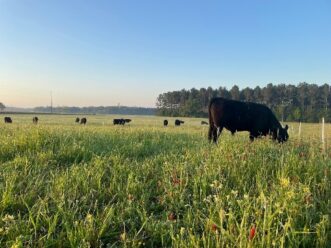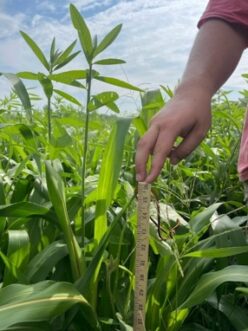Measuring forage mass is a crucial step in adjusting the stocking rate on grazing systems. This helps to reduce the chances of overgrazing pastures and improves forage utilization while accounting for plant and animal requirements and improving stand persistence.
Important Concepts for Grazing Systems

Figure 1. Animals grazing a cool-season forage system. Image credit: Liliane Silva, Clemson University Cooperative Extension.
Grazing management practices play an important role in forage production and quality and the sustainability and feasibility of forage-livestock systems (figure 1).1 Measuring forage mass is essential to estimate forage production and adjust the stocking rate (SR) and carrying capacity.2 The stocking rate is defined as the number of animals grazing within a unit of land over a given period of time.2 When SR is incorrect, it can lead to undergrazing or overgrazing conditions, and the latter can lead to forage stand degradation over time (figure 1). The carrying capacity is defined as the maximum number of animals or animal units that a pasture can support over a given period without compromising stand health. Measuring the forage mass reduces the chances of overgrazing pastures, which compromises forage quality, stand longevity, and animal performance.
Grazing Methods
Continuous and rotational stocking are the most used grazing methods. Under continuous stocking, animals have unrestricted access to a specific unit of land during the grazing season.2 Animals can selectively graze unless the stocking rate is high. If overstocked, animals may deplete plant storage reserves and damage growing points, leading to overgrazing and compromising stand persistence. Under rotational stocking, the pasture is subdivided into paddocks on which there will be alternate grazing and rest periods during the grazing season.2 This method requires a higher management level and more labor but can provide better distribution of recycled nutrients and more rapid plant recovery. In grazing systems, stocking rate adjustments are essential to maintaining a healthy forage stand. There are additional stocking methods available to be used by producers that will be included in an upcoming Land-Grant Press publication, “Grazing Management Methods and Considerations”.
Measuring Forage Mass
Forage mass refers to the total dry weight of forage per unit of land area at a specific time.3 In grazing systems, the general rule is to “take half, leave half” of the forage mass. An adequate estimate of forage mass helps to improve forage utilization, production, and quality to support animal nutritional requirements. Forage mass can be measured using the following methods.
Method 1 – Canopy Height

Figure 2. A pasture ruler is used to measure forage mass in an alfalfa-bermudagrass pasture. Image credit: Liliane Silva, Clemson University Cooperative Extension.
This method consists of measuring forage mass using a pasture (forage) ruler (figure 2), and it is a viable option to estimate the pounds of grazeable forage mass in a stand.4 When using a forage ruler, the recommendation is to randomly collect canopy height from several sites throughout the pasture to obtain an average height. Then, use table 1 to estimate the pounds of grazeable forage per inch in the pasture. This measurement does not account for the stand density, so this is a consideration when determining the management to be applied because it interferes with how much forage is grown per area. If there are open spaces or the stand is thinning out in some spots, that will represent lesser forage production in those areas. Therefore, observing the variations throughout a stand is important to estimate the grazeable forage mass present. This is important because it will impact the forage growth per area on a pasture. For more information on how to acquire and use the pasture ruler, please contact your local Livestock and Forages Extension Agent. Contact information for Clemson Cooperative Extension county offices and Agents is available on the website.
Table 1. Pounds of grazeable forage mass per inch in the pasture. Adapted from Silva et al. (2021).5
| Forage species | Average (lb) | Range (lb) |
|---|---|---|
| Alfalfa (grazing types) | 225 | 45–400 |
| Annual ryegrass | 250 | 75–400 |
| Bahiagrass | 200 | 100–350 |
| Bermudagrass | 260 | 150–500 |
| Native warm-season grasses | 100 | 50–250 |
| Orchardgrass | 180 | 75–300 |
| Small grains | 150 | 75–250 |
| Tall fescue | 210 | 100–350 |
| Tall fescue + clover | 190 | 80–325 |
Method 2 – Cut and Dry Sampling Method

Figure 3. Quadrat frame detail (left) and quadrat detail in use (right) in an alfalfa-bermudagrass pasture. Image credit: Liliane Silva, Clemson University Cooperative Extension.
A quadrat (frame with a known area, figure 3) is needed for this method. The quadrat can be built using PVC pipe, wire, or wood. Four 18-in pieces will give the quadrat a 2.25 ft2 area for a square design. The quadrat area is required to calculate the forage mass per acre. Randomly select a site in the pasture that represents the average pasture condition (canopy height and density), place the quadrat down, and harvest the forage within the quadrat, placing the biomass in a paper bag (figure 3). Repeat several times in the pasture using a zig-zag pattern to avoid bias and place each sample in a separate bag. Once harvested, dry the sample in a dedicated farm microwave.4
For the drying process, a glass of water, a plate with forage samples, and a scale (bathroom or kitchen type) are needed to dry the samples. First, weigh the plate and tare it (the weight of the plate when empty), then weigh 3.4 oz of harvested forage on the plate. Place the glass of water inside the microwave with the plate and set it to high mode for two minutes. The water will help to dissipate the heat and avoid combustion. After two minutes, allow the sample to cool off and weigh it. Repeat this process until the dried sample weight remains constant. Remember to change the water as needed to avoid boiling. Repeat with the different samples and determine the average for the most accurate measurement. Next, use the correct area formula for the shape of the quadrat to calculate forage mass (dry weight [ounces]/quadrat area [feet2]) and then convert it to pounds per acre. To convert ounce per feet2 to pounds per acre, multiply by 2,723. Please note these samples should not be used to submit for forage quality analysis.
Method 3 – Visual Estimation
It is possible to estimate forage mass in a stand visually. This method requires training by harvesting several forage samples from an area of known size (see method #2) to calibrate your visual estimates with the actual forage mass in those sites. This is recommended to account for the variation in canopy height and density on pastures which will influence the amount of forage accumulated throughout a pasture. Low-density areas in the pasture will have fewer plants per area and less forage accumulated compared to other portions with optimal canopy density. Those areas tend to be more open and increase the tendency for weed growth. A better understanding of the variations in accumulation throughout a pasture canopy helps provide a closer visual estimate of forage mass.4
Adjusting Stocking Rate on Pastures
Follow the steps below to adjust the stocking rate based on the forage mass measured on a given pasture.3,6
For the number of paddocks needed (NP), divide the number of days of rest by the days of grazing that will be given to that pasture and add 1: NP = (days of rest / days of grazing) + 1
Example: NP = (28 days of rest / 4 days of grazing) + 1= 8 paddocks
Then, estimate the acres required per paddock (AP) by using the formula below:
whereas animal weight should be an average of the group of animals that will graze that area. DMI stands for the dry matter intake per animal per day (in %).7 Forage mass means forage dry matter (see method #2) and the % of forage utilization expected for that pasture.
Example: AP = ([650 lb x 3%] x 40 animals x 4 days / [3000 lb/acre x 50%)]) = 2.1 acres
The total acres required per grazing cycle is calculated by multiplying the number of paddocks per acreage of each paddock.
Example: 8 paddocks x 2.1 acres per paddock = 16.8 total acres required
Stocking rate is calculated by dividing the number of animals grazing by the total number of acres grazed.
Example: SR = (40 heads) / (16.8 acres) = 2.4 head per acre
Stocking density (SD) is defined as the number of animals having access to a specific pasture area at a particular time, and it is an instantaneous value. The SD is calculated as:
SD = (number of animals grazing) / (paddock size in acres)
Example: SD = (40 heads) / (2.1-acre paddock) = 19 head per acre
For more information about estimating your forage mass and adjusting your stocking rate, consult your local Extension Agent for questions.
References Cited
- Sollenberger LE, Moore JE, Allen VG, Pedreira CGS. 2005. Reporting forage allowance in grazing experiments. Crop Science. 2005 May;45(3):896–900.
- Allen VG, Batello C, Berretta EJ, Hodgson J, Kothmann M, Li X, McIvor J, Milne J, Morris C, Peeters A, Sanderson M. An international terminology for grazing lands and grazing animals. Grass and Forage Science. 2011 Mar;66(1):2–28.
- Burns JC, Lippke H, Fisher DS. The relationship of herbage mass and characteristics to animal responses in grazing experiments. In: Marten GC, editor. Grazing research: design, methodology, and analysis. Madison (WI): Crop Science Society of America and American Society of Agronomy; 1989. p. 7–19.
- Marten GC, editor. Grazing research: design, methodology, and analysis. Madison (WI): Crop Science Society of America and American Society of Agronomy; 1989. doi:10.2135/cssaspecpub16.
- Silva L, Griffin M, Dillard L, Mullenix K. 2021. Measuring forage mass to adjust stocking rate. Auburn University (AL): Alabama Cooperative Extension System; 2021 Apr. ANR-2752. https://www.aces.edu/blog/topics/farming/measuring-forage-mass-to-adjust-stocking-rate/.
- Hodgson J. Nomenclature and definitions in grazing studies. Grass and Forage Science. 1979 Mar;34(1):11–17.
- National Academies of Sciences, Engineering, and Medicine. Nutrient requirements of beef cattle. 8th ed. Washington (DC): The National Academies Press; 2016. doi:10.17226/19014.
Additional Resources
Dubeux J, Wallau M, Vendramini J, Silva L, Griffin J, DiLorenzo N, Santos E. Estimating herbage mass on pastures to adjust stocking rate. Gainesville (FL): University of Florida, IFAS Extension; 2019 Aug. #SS-AGR-434. https://edis.ifas.ufl.edu/publication/AG434.


